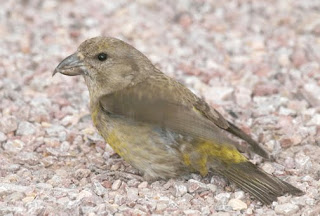There are two routes to Yellowstone from the Badlands.
The southern route - US 26 from Casper, WY to Dubois - goes through the Bridger-Teton National Forest on the Wyoming Centennial Scenic Byway through Togwotee Pass (9,658 ft) north of Jackson. The northern route -US 14 - goes through Granite Pass (9,033 ft) on the Bighorn Scenic Byway. On the advice of my trusted AAA travel consultant, we took the northern route.
In retrospect, it was not the best choice for me (vertigo issues) and the Prius (ground clearance issues). The road construction from Ranchester up the Bighorns to Burgess Junction was frightening. Picture a one lane dirt road, two lane traffic, no guard rails and potholes so big they nearly swallowed the Prius. I cringe just thinking of the sound of the front fender scraping.
This stretch of road alerted me to one of the few "negatives" about the aerodynamic Prius: the 5" ground clearance.
The up-hill ride into the Bighorns seemed to take forever. But I managed to enjoy the fresh, new pavement (and the scenery) on the downhill side to Shell, Wyoming.
 We spent the night in Cody and got up bright and early for the ride in to Yellowstone on yet another scenic byway (named after Buffalo Bill Cody), through America's first National Forest, the Shoshone. Great scenery.
We spent the night in Cody and got up bright and early for the ride in to Yellowstone on yet another scenic byway (named after Buffalo Bill Cody), through America's first National Forest, the Shoshone. Great scenery. All along the road - from Yellowstone's east entrance to Fishing Bridge - was sobering evidence of past fires.
But not much wildlife action. We stopped to watch White Pelicans and a very friendly Common Raven.
Then just before Fishing Bridge on the north side of Yellowstone Lake. Off in the distance, Bison!
As I pulled on to the shoulder, a car coming in the opposite direction, slowed to a stop. The driver rolled down his window and said: "Don't stop here. There's a big herd just down the road - in the road." Before he could finish, a man in the car behind us honked impatiently, then zoomed past. He would be the first of many drivers who just didn't seem to feel the harmony between man, nature and machine.
Minutes later, we caught up with the him, and a big herd of bison.
We waited for the largest land mammals in North America to cross the road. I've never been so close to bulls, cows and calves. August is the end of mating season, and even the calves seemed to dwarf our Prius. They snorted and bumped into each other.
This bull sauntered right up to my window.

But no black-billed magpies riding their backs - picking the insects off their hides. No cowbirds either. Tom encouraged me to put the petal to the metal. When the opportunity to move past them arose, I took it.













